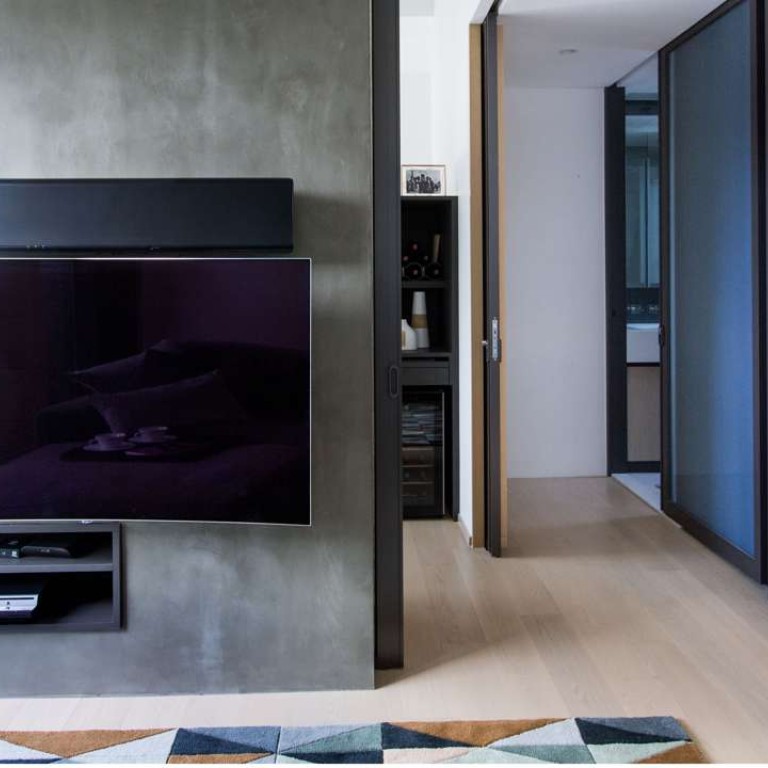
A small, smart Hong Kong apartment packed with personality
At 540 square feet, it may not be the most spacious but this Kennedy Town apartment boasts a sizeable bedroom, a walk-in wardrobe and plenty of storage, the highlight of which is the cabinet that houses the owner’s designer-shoe collection
When Kaitlyn Leung Kan-yen first looked at apartments in Kennedy Town, three years ago, it was the vibrant neighbourhood’s similarities to the Canadian city of Toronto that appealed to her.
“Its proximity to the water, the trams running into the city from just outside the door, the friendly vibe, the boardwalk, the local shops and restaurants – they all reminded me of where I used to live,” she says.
But the perfect home remained elusive until she walked into a 540-sq-ft, three-bedroom apartment in The Hudson early last year.
“I am very particular,” Leung says, with a laugh, adding that she had agreed to visit the flat initially just to mollify her long-suffering agent, who had arranged an early viewing. “On paper, it looked too small for me, but I walked in and fell in love with the potential for a walk-in closet [carved out of one bedroom].”
With windows on three sides and two small balconies, the apartment had what Leung – a Hong Kong-born financial executive who moved to Canada after high school and returned in 2006 – was looking for, and she signed on the dotted line to become the first person to take possession of an apartment in the high-rise on trendy Davis Street.
Leung also wanted to modify the space to provide storage elsewhere.
Having seen Debi Yeung-Salansy’s work featured in Post Magazine, Leung got in touch and was immediately impressed by the designer’s perspicacity.
“I had a spare room in my old apartment but probably in 10 years only two visitors to stay. Debi pointed out what a waste this was and encouraged me to think about the space in my new apartment in terms of my everyday needs.”
Which is why one small bedroom was set aside for a walk-in wardrobe and the other two knocked together to create a generous bedroom. The apartment’s 3.65-metre ceiling height allowed Yeung-Salansy to build an elevated bed platform that afforded generous storage space for her client’s sports equipment, extra bedding, luggage and other sundry items.
A large built-in cabinet, with a chest of drawers on one side and a small desk with further storage on the other, separates the bedroom from the rest of the apartment while still allowing plenty of light to flood through. One of two doors was blocked off and shallow shelving created on the bedroom side for yet more storage.
Because the apartment was new, and the bathroom and kitchen were finished to a high specification with Miele and Siemens appliances, changes to those areas were unnecessary. At Leung’s request, however, Yeung-Salansy installed a feature wall in the main living area that extended on to the balcony. The concrete surface of the wall helps to connect outside and indoor areas. And on the bedroom side of the wall, it provides, you guessed it, even more storage space.
A frequent traveller, Leung was also keen to use technology to her advantage, which is why “smart living” features have been installed throughout the home. A touch of a button on her phone or iPad allows her to turn on the lights and air conditioning from anywhere in the world.
Leung didn’t move in with any of the furniture from her old apartment (“except that carpet Debi hates”) and instead helped Yeung-Salansy furnish the compact interior from scratch. Their natural rapport is evident: “Debi’s direct and I like that,” says Leung. “I respect and trust her advice.”
The pair may not agree on the apartment’s highlight, though. Leung’s favourite spot is a shoe cabinet accommodating 70-plus pairs of designer shoes.
“Even if I don’t wear them, it makes me happy just to look at them – they’re so pretty!” she laughs.




Shoe cabinet A cabinet by the main door houses Leung’s designer shoes.




Smart glass Although the apartment sits on a high floor, the homeowner felt the large kitchen window left the apartment too exposed. A blind or curtain would have been a fire hazard and blocked out light. Instead, Debi Yeung-Salansy installed a glass panel (HK$45,000) in front of the existing window that can change from transparent to translucent at the touch of a button.
